MITSUBISHI 3000GT 1991 Service Manual
Manufacturer: MITSUBISHI, Model Year: 1991, Model line: 3000GT, Model: MITSUBISHI 3000GT 1991Pages: 1146, PDF Size: 76.68 MB
Page 1011 of 1146
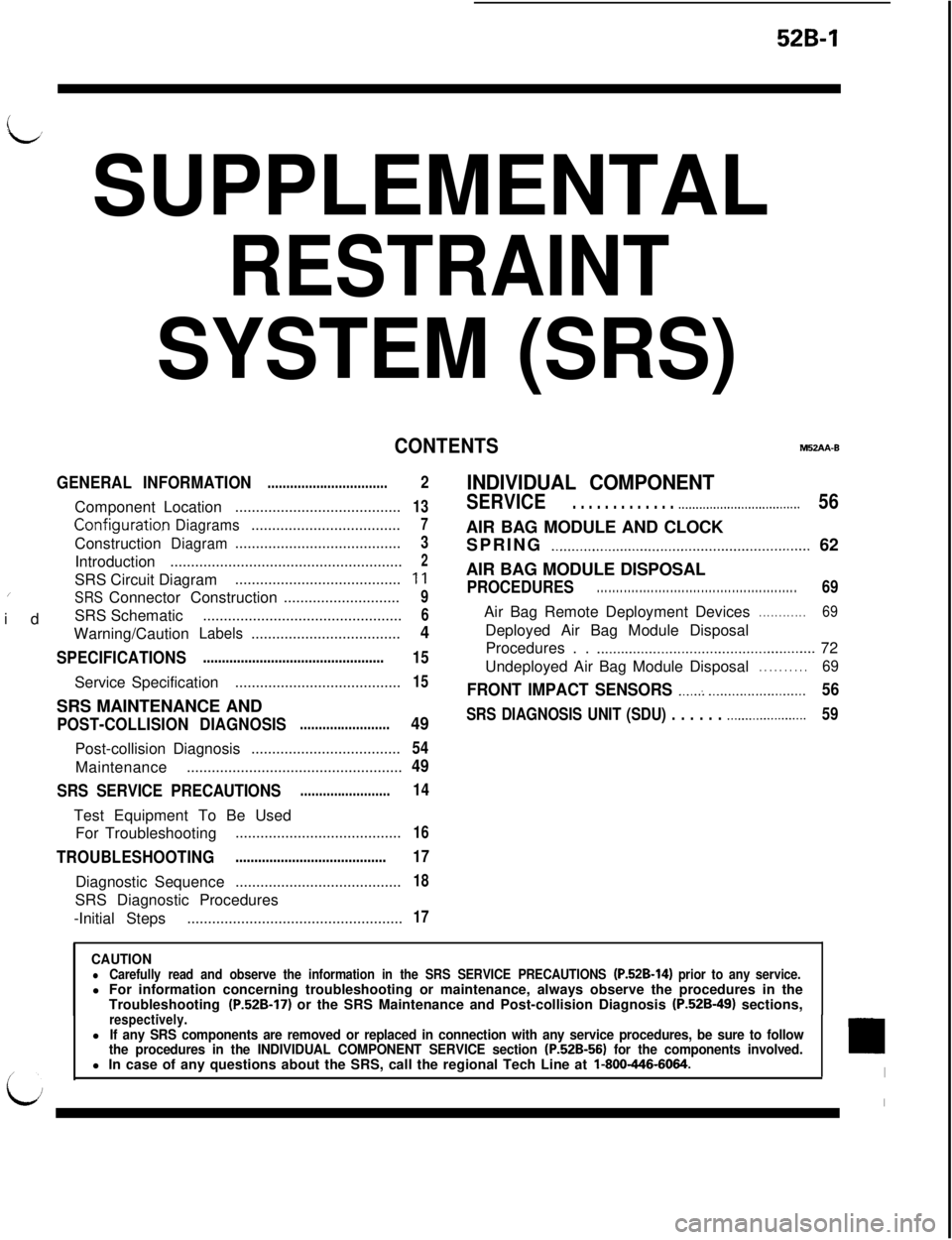
528-l
L’ SUPPLEMENTAL
RESTRAINT
SYSTEM (SRS)
CONTENTSM52AA-B
GENERAL INFORMATION
................................ComponentLocation
........................................
Configurati0.nDiagrams....................................Construction
Diagram........................................Introduction
........................................................SRS Circuit Diagram
......................................../idSRSConnector Construction............................SRS Schematic
................................................Warning/Caution
Labels....................................
SPECIFICATIONS................................................ServiceSpecification
........................................SRS MAINTENANCE AND
POST-COLLISION DIAGNOSIS........................Post-collisionDiagnosis
....................................Maintenance
....................................................
SRS SERVICE PRECAUTIONS........................Test Equipment To Be Used
For Troubleshooting
........................................
TROUBLESHOOTING........................................DiagnosticSequence
........................................SRS Diagnostic Procedures
-Initial Steps
....................................................
2
13
7
3
2
11
9
6
4
15
15
49
54
49
14
16
17
18
17
INDIVIDUAL COMPONENT
SERVICE. . . . . . . . . . . . . .._................................56AIR BAG MODULE AND CLOCK
SPRING
._..........._......................._.........._............... 62
AIR BAG MODULE DISPOSAL
PROCEDURES. . . . . . . . . . . . . . . . . . . . . . . . . . . . . . . . . . . . . . . . . . . . . . . . . . . .69Air Bag Remote Deployment Devices
. . . . . . . . . . . .69Deployed Air Bag Module Disposal
Procedures . .
.._..........._....................................... 72
Undeployed Air Bag Module Disposal
. . . . . . . . . .69
FRONT IMPACT SENSORS ._....: _._..._..................56
SRS DIAGNOSIS UNIT (SDU) . . . . . . .._...................59
CAUTIONlCarefully read and observe the information in the SRS SERVICE PRECAUTIONS (P.52B-14) prior to any service.l For information concerning troubleshooting or maintenance, always observe the procedures in the
Troubleshooting
(P.52B-17) or the SRS Maintenance and Post-collision Diagnosis (P.52B-49) sections,_respectively.lIf any SRS components are removed or replaced in connection with any service procedures, be sure to follow
the procedures in the INDIVIDUAL COMPONENT SERVICE section (P.52B-56) for the components involved.l In case of any questions about the SRS, call the regional Tech Line at l-800-446-6064.
Page 1012 of 1146
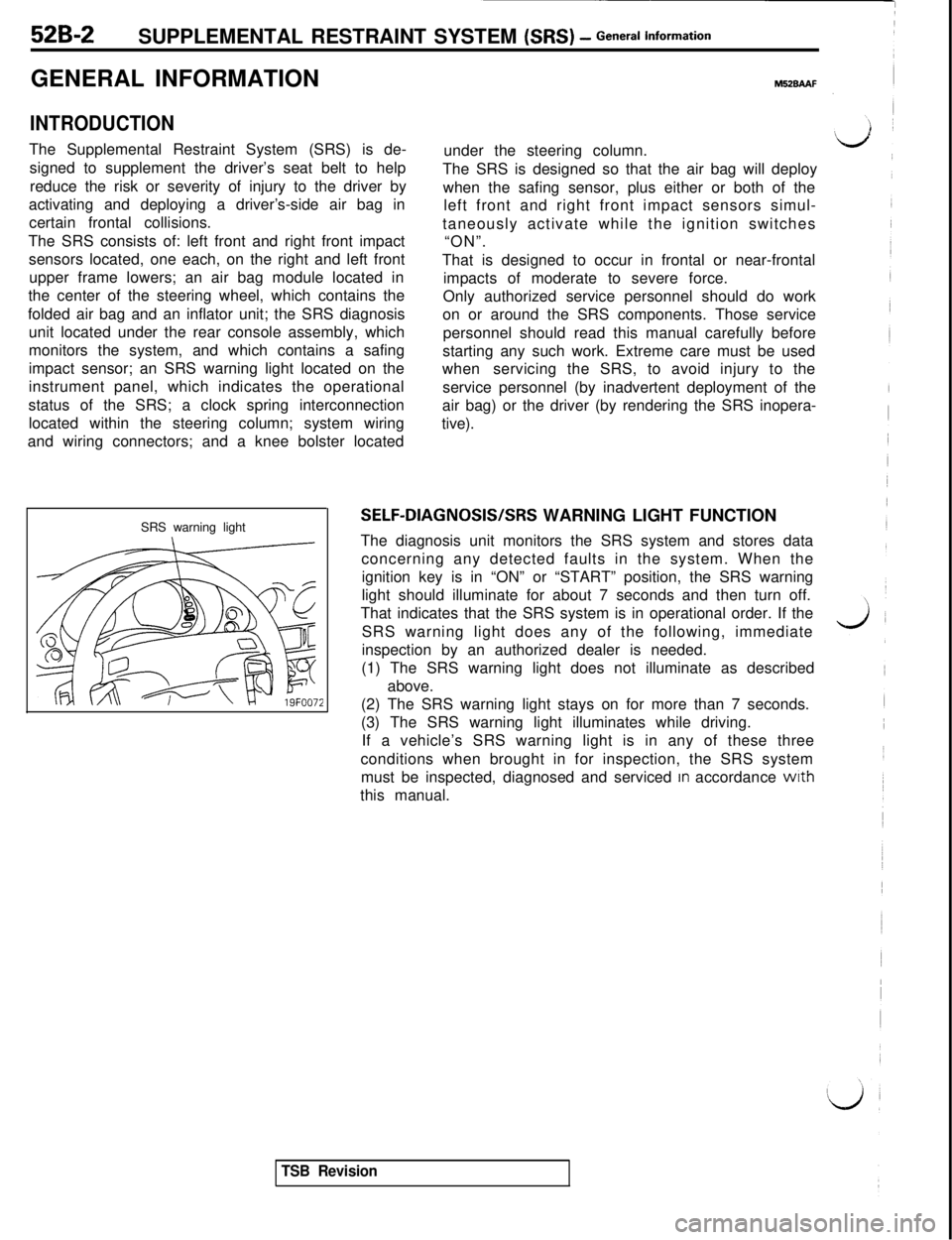
52B-2SUPPLEMENTAL RESTRAINT SYSTEM (SRS) - General informationGENERAL INFORMATION
INTRODUCTIONThe Supplemental Restraint System (SRS) is de-
signed to supplement the driver’s seat belt to help
reduce the risk or severity of injury to the driver by
activating and deploying a driver’s-side air bag in
certain frontal collisions.
The SRS consists of: left front and right front impact
sensors located, one each, on the right and left front
upper frame lowers; an air bag module located in
the center of the steering wheel, which contains the
folded air bag and an inflator unit; the SRS diagnosis
unit located under the rear console assembly, which
monitors the system, and which contains a safing
impact sensor; an SRS warning light located on the
instrument panel, which indicates the operational
status of the SRS; a clock spring interconnection
located within the steering column; system wiring
and wiring connectors; and a knee bolster located
SRS warning light
M52BAAFunder the steering column.
The SRS is designed so that the air bag will deploy
when the safing sensor, plus either or both of the
left front and right front impact sensors simul-
taneously activate while the ignition switches
“ON”.
That is designed to occur in frontal or near-frontal
impacts of moderate to severe force.
Only authorized service personnel should do work
on or around the SRS components. Those service
personnel should read this manual carefully before
starting any such work. Extreme care must be used
whenservicing the SRS, to avoid injury to the
service personnel (by inadvertent deployment of the
air bag) or the driver (by rendering the SRS inopera-
tive).
SELF-DIAGNOSIS/SRS WARNING LIGHT FUNCTION
The diagnosis unit monitors the SRS system and stores data
concerning any detected faults in the system. When the
ignition key is in “ON” or “START” position, the SRS warning
light should illuminate for about 7 seconds and then turn off.
That indicates that the SRS system is in operational order. If the
SRS warning light does any of the following, immediate
inspection by an authorized dealer is needed.
(1) The SRS warning light does not illuminate as described
above.
(2) The SRS warning light stays on for more than 7 seconds.
(3) The SRS warning light illuminates while driving.
If a vehicle’s SRS warning light is in any of these three
conditions when brought in for inspection, the SRS system
must be inspected, diagnosed and serviced
In accordance wrth
this manual.
TSB Revision
Page 1013 of 1146
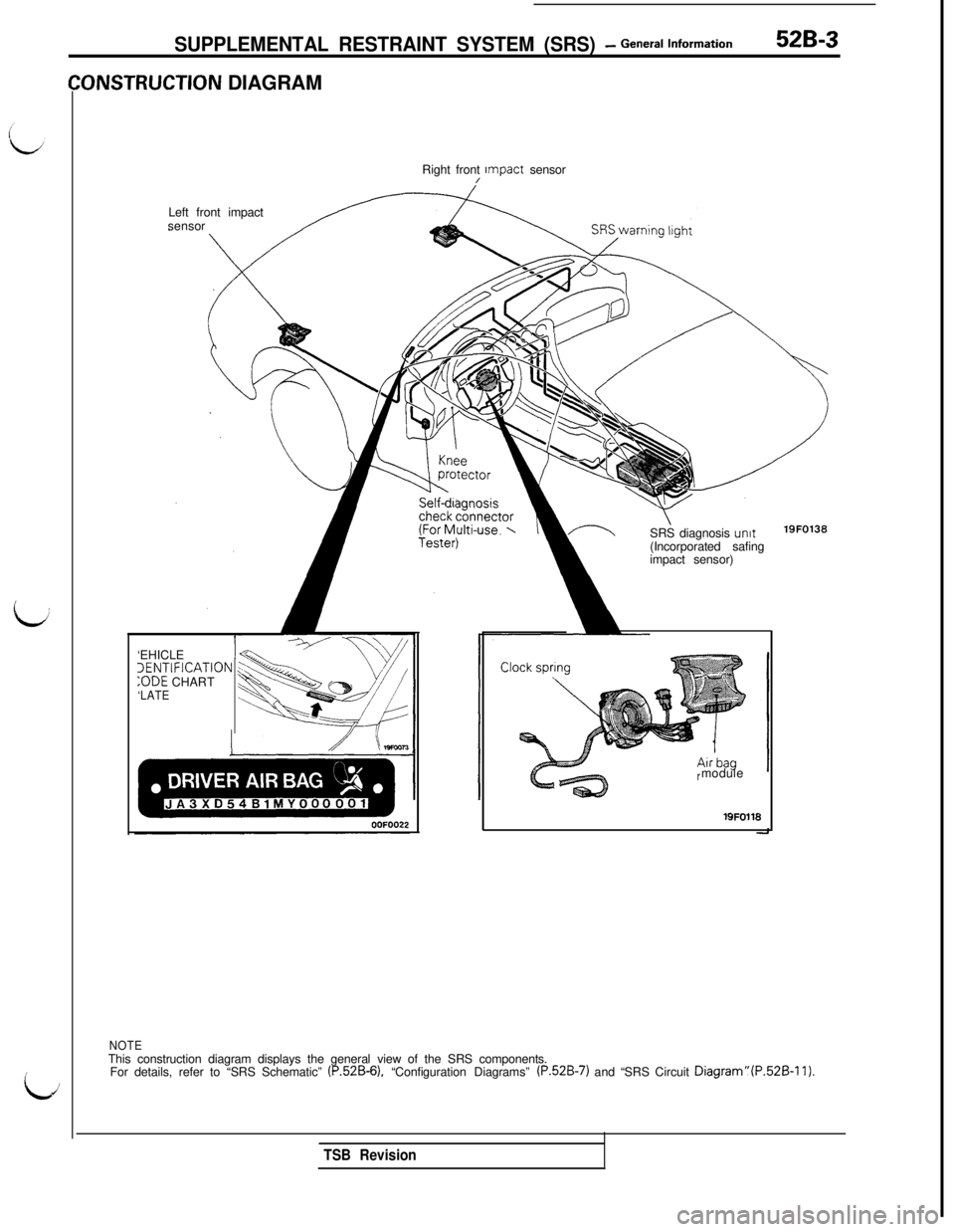
c
LJ
SUPPLEMENTAL RESTRAINT SYSTEM (SRS) - General information52B-3
ONSTRUCTION DIAGRAM
Right front Impact sensor
/Left front impact
sensor
SRS diagnosis
unit(Incorporated safing
impact sensor)19FO138‘EHICLE
1~ENTIFICATION:ODE CHART
‘LATEmodulelQFO118
NOTEThis construction diagram displays the general view of the SRS components.
For details, refer to “SRS Schematic”
(P.52B-6). “Configuration Diagrams” (P.52B-7) and “SRS Circuit Diagram”(P.52B-11).
TSB Revision
Page 1014 of 1146
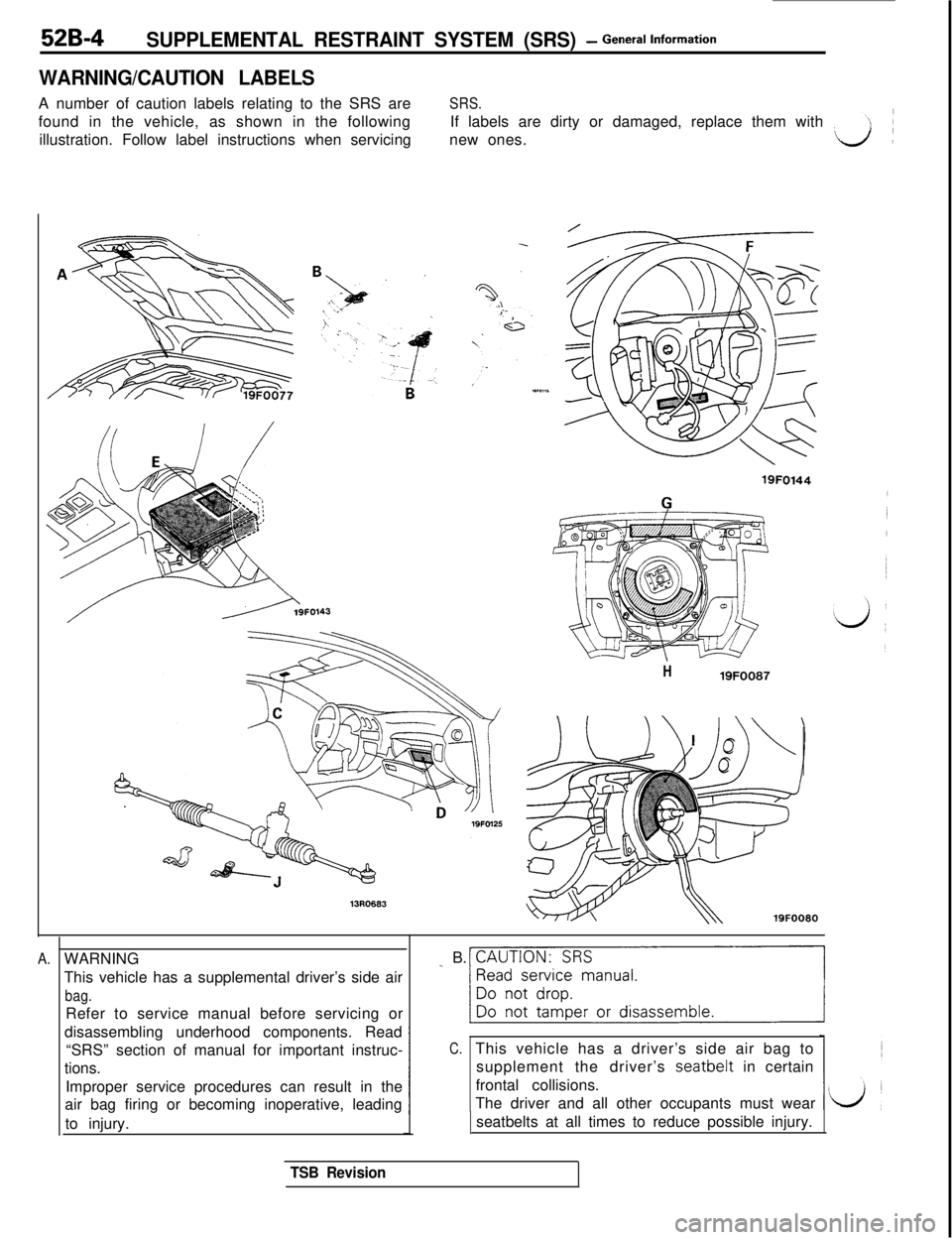
52B-4SUPPLEMENTAL RESTRAINT SYSTEM (SRS) - General lnform=*ion
WARNING/CAUTION LABELSA number of caution labels relating to the SRS are
SRS.found in the vehicle, as shown in the followingIf labels are dirty or damaged, replace them with
illustration. Follow label instructions when servicingnew ones.
//----?9FO143
A.
H19FOO87
19FOO80WARNING
This vehicle has a supplemental driver’s side air
bag.Refer to service manual before servicing or
disassembling underhood components. Read
“SRS” section of manual for important instruc-
tions.
Improper service procedures can result in the
air bag firing or becoming inoperative, leading
to injury.
_ B. CAUTION: SRS
~1
C.This vehicle has a driver’s side air bag to
supplement the driver’s
seatbelt in certain
frontal collisions.
The driver and all other occupants must wear
seatbelts at all times to reduce possible injury.
TSB Revision
Page 1015 of 1146
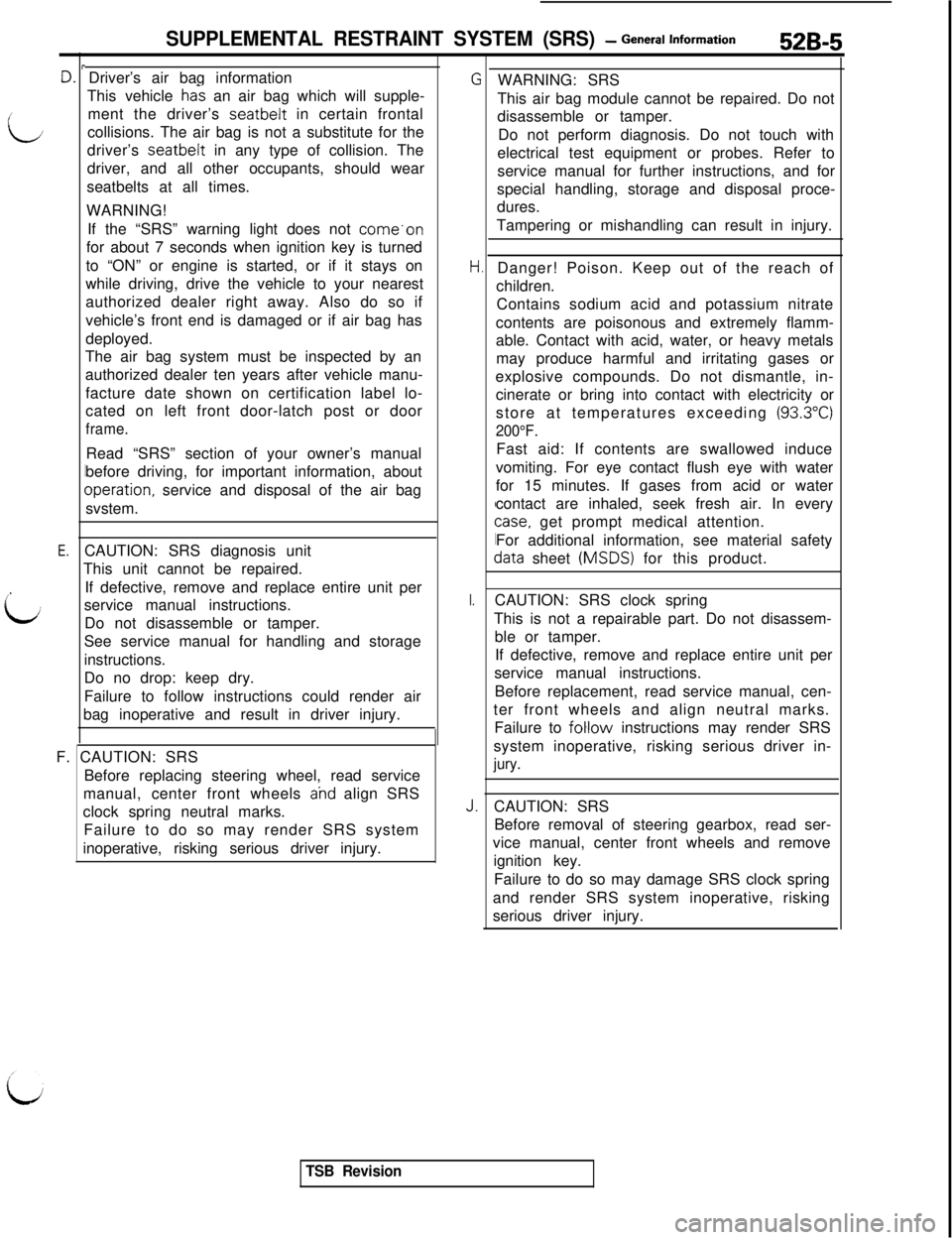
SUPPLEMENTAL RESTRAINT SYSTEM (SRS) - General lnform=*ion52B-5
r1.c
L
E.
,
iiCAUTION: SRS diagnosis unit
This unit cannot be repaired.
If defective, remove and replace entire unit per
service manual instructions.
Do not disassemble or tamper.
See service manual for handling and storage
instructions.Driver’s air bag information
This vehicle
ha% an air bag which will supple-
ment the driver’s seatbelt in certain frontal
collisions. The air bag is not a substitute for the
driver’s seatbelt in any type of collision. The
driver, and all other occupants, should wear
seatbelts at all times.
WARNING!
If the “SRS” warning light does not come.on
for about 7 seconds when ignition key is turned
to “ON” or engine is started, or if it stays on
while driving, drive the vehicle to your nearest
authorized dealer right away. Also do so if
vehicle’s front end is damaged or if air bag has
deployed.
The air bag system must be inspected by an
authorized dealer ten years after vehicle manu-
facture date shown on certification label lo-
cated on left front door-latch post or door
frame.Read “SRS” section of your owner’s manual
before driving, for important information, about
Dperation, service and disposal of the air bag
svstem.
Do no drop: keep dry.
Failure to follow instructions could render air
bag inoperative and result in driver injury.
F. CAUTION: SRS
Before replacing steering wheel, read service
manual, center front wheels
ahd align SRS
clock spring neutral marks.
Failure to do so may render SRS system
inoperative, risking serious driver injury.
I.
J.WARNING: SRS
This air bag module cannot be repaired. Do not
disassemble or tamper.
Do not perform diagnosis. Do not touch with
electrical test equipment or probes. Refer to
service manual for further instructions, and for
special handling, storage and disposal proce-
dures.
Tampering or mishandling can result in injury.
Danger! Poison. Keep out of the reach of
children.
Contains sodium acid and potassium nitrate
contents are poisonous and extremely flamm-
able. Contact with acid, water, or heavy metals
may produce harmful and irritating gases or
explosive compounds. Do not dismantle, in-
cinerate or bring into contact with electricity or
store at temperatures exceeding
(93.3”C)
200°F.Fast aid: If contents are swallowed induce
vomiting. For eye contact flush eye with water
for 15 minutes. If gases from acid or water
contact are inhaled, seek fresh air. In every
case, get prompt medical attention.
For additional information, see material safety
data sheet (MSDS) for this product.
CAUTION: SRS clock spring
This is not a repairable part. Do not disassem-
ble or tamper.
If defective, remove and replace entire unit per
service manual instructions.
Before replacement, read service manual, cen-
ter front wheels and align neutral marks.
Failure to
foHow instructions may render SRS
system inoperative, risking serious driver in-
jury.CAUTION: SRS
Before removal of steering gearbox, read ser-
vice manual, center front wheels and remove
ignition key.
Failure to do so may damage SRS clock spring
and render SRS system inoperative, risking
serious driver injury.
TSB Revision
Page 1016 of 1146
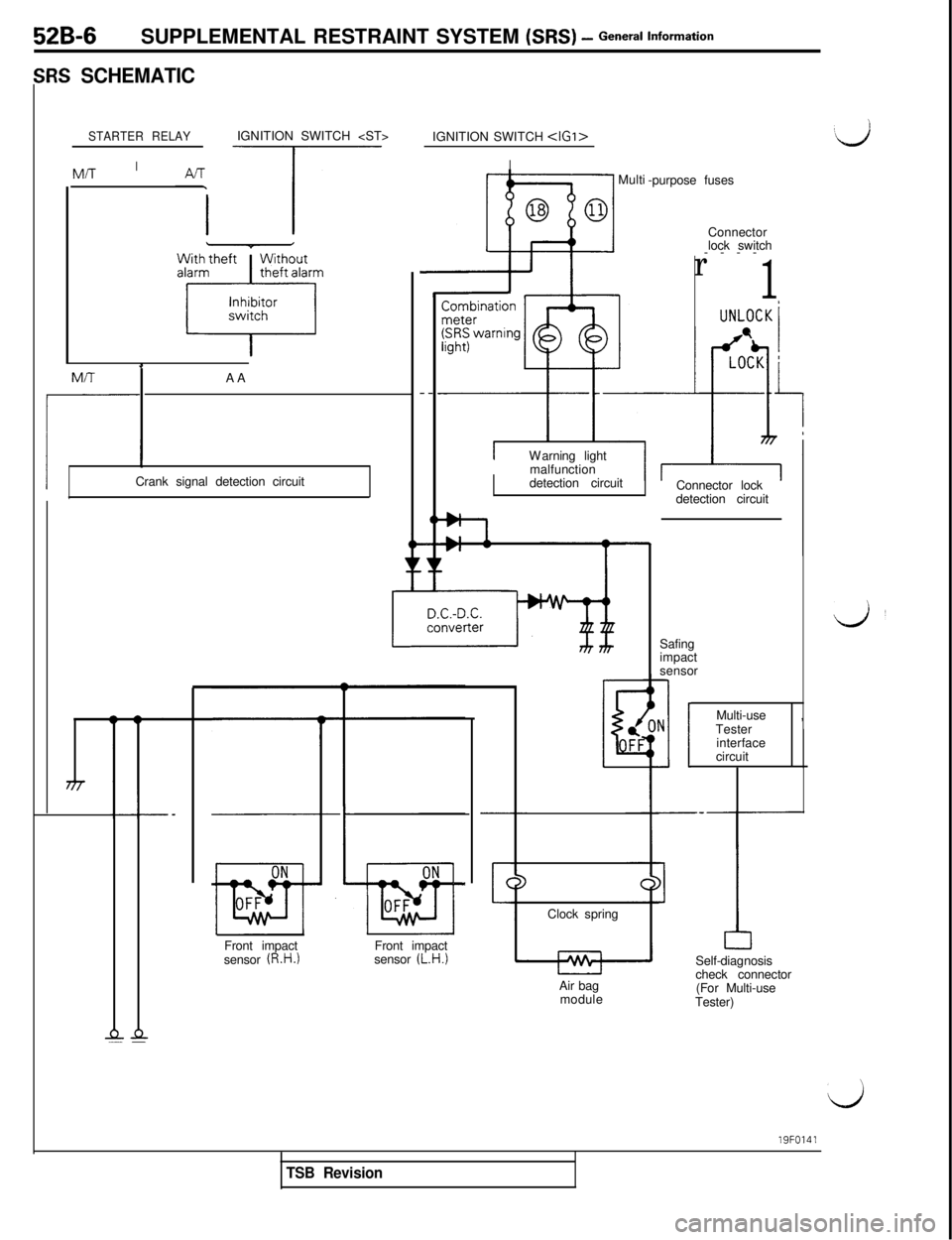
52B-6SUPPLEMENTAL RESTRAINT SYSTEM (SRS) - General Information
;RS SCHEMATIC
STARTER RELAYIGNITION SWITCH
I
‘dIGNITION SWITCH
IMulti
-purpose fuses
Connector
lock switch
----
r
1
UNLOCKiM/T -AA
IWarning light
malfunction
detection circuitICrank signal detection circuit
Connector lock
detection circuit
Safing
impact
sensor
1
N
i-Multi-use ,
Tester
interface
circuit
Self-diagnosis
check connector
(For Multi-use
Tester)
19FO141Front impact
sensor
(L.H.)Clock spring
Front impact
sensor (R.H.)IP-l-Air bag
module
TSB Revision
Page 1017 of 1146
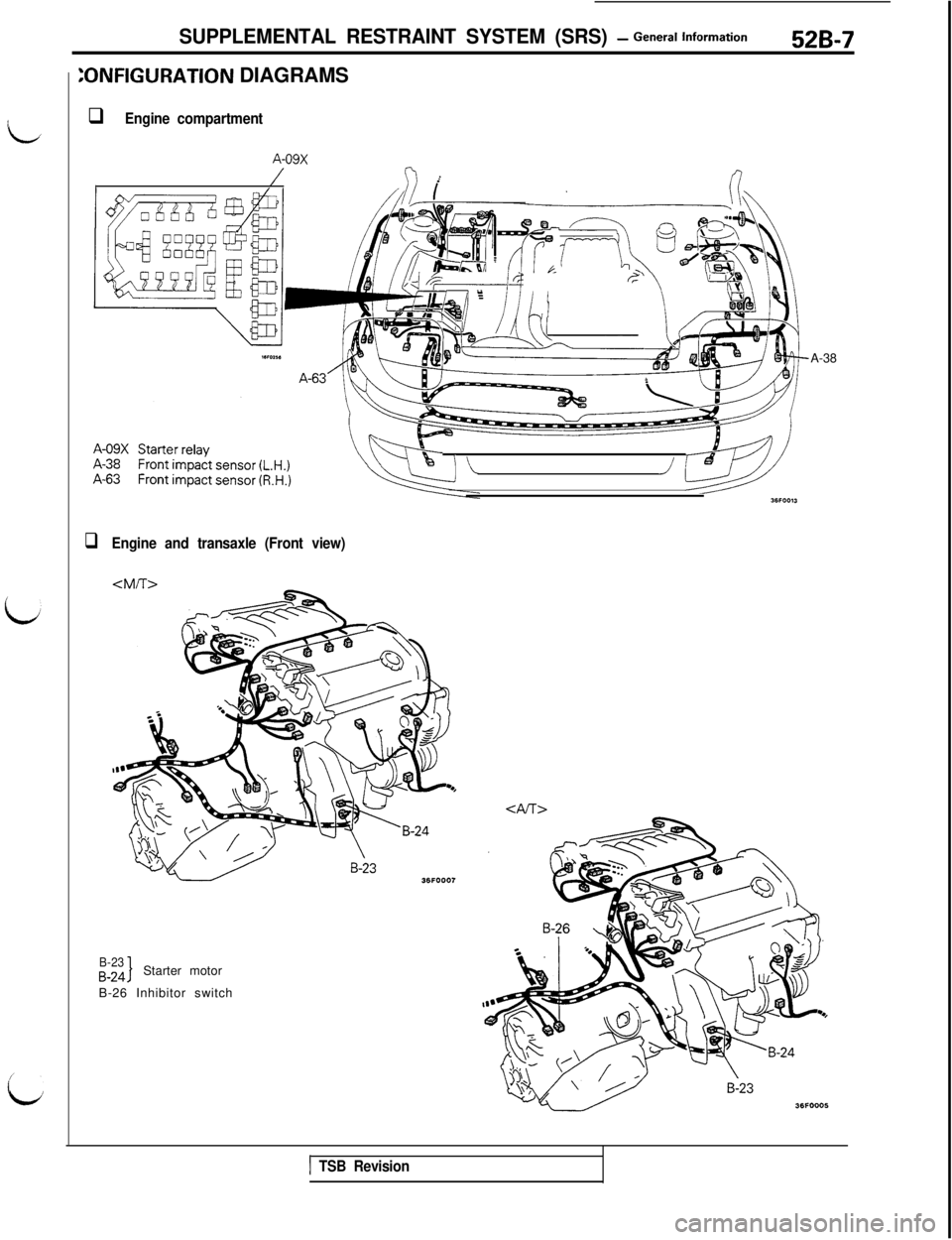
i
SUPPLEMENTAL RESTRAINT SYSTEM (SRS) - General Information526-7
:ONFIGURATION DIAGRAMS
q Engine compartmentA-09X
/
+m*,.16,IIfc’ \=is\ IL\\
\
\iw I \B/f---TJwdD
’ L&/Y&!!
3BFOO13
qEngine and transaxle (Front view)
B-23B-24Starter motor
B-26 Inhibitor switchA-38
1 TSB Revision
Page 1018 of 1146
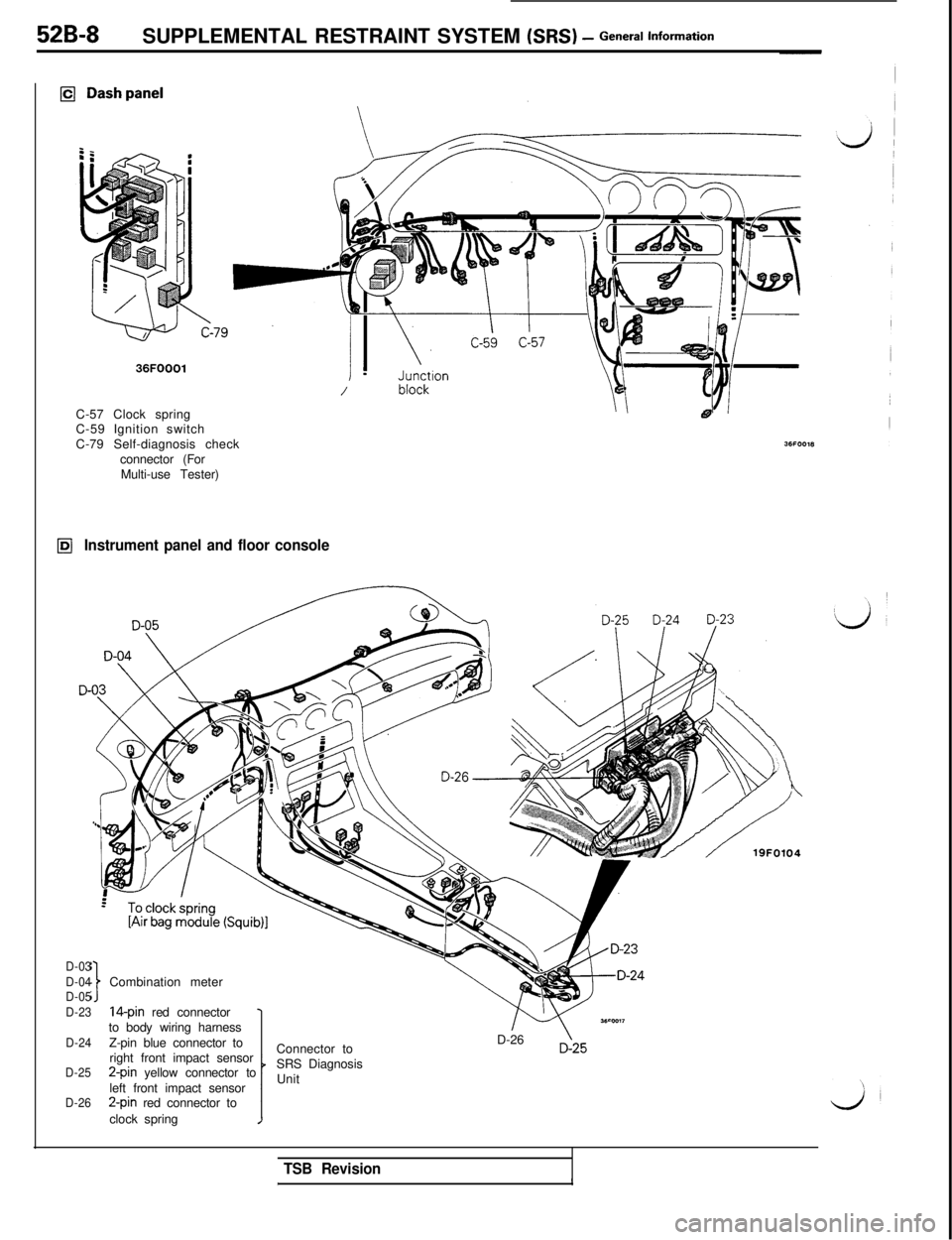
52B-8SUPPLEMENTAL RESTRAINT SYSTEM (SRS) - General Information
36FOOOlJ/C-57 Clock spring
C-59 Ignition switch
C-79 Self-diagnosis check
connector (For
Multi-use Tester)
IbJInstrument panel and floor console
D-
D-03
D-04Combination meter
D-05
D-2314-pin red connector
to body wiring harness
D-24Z-pin blue connector to
right front impact sensor
D-252-pin yellow connector to
left front impact sensor
D-262-pin red connector to
clock springConnector to
SRS Diagnosis
UnitD-26225
TSB Revision,1
Page 1019 of 1146
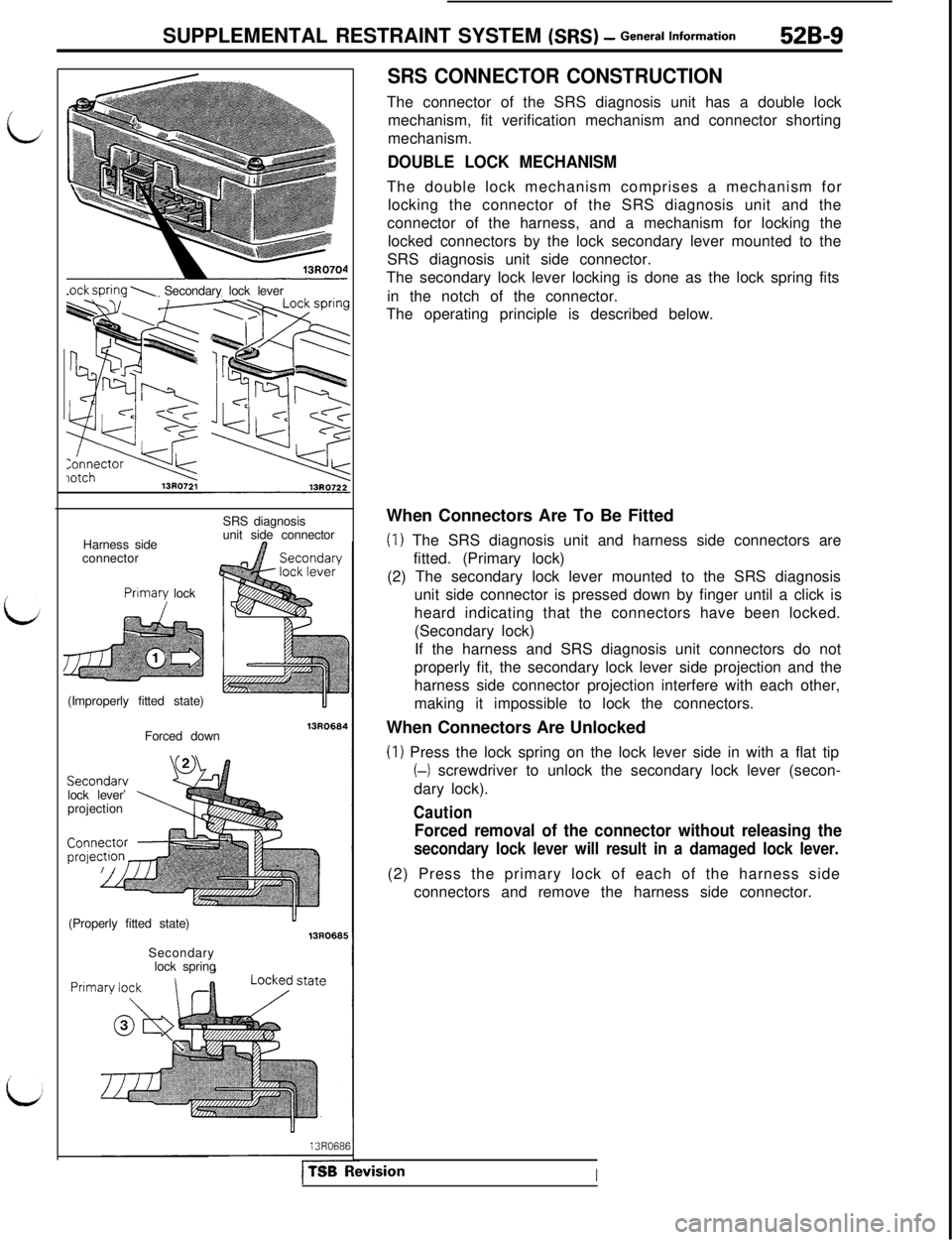
SUPPLEMENTAL RESTRAINT SYSTEM (SRS) - General Information52B-9.ock sprinq
\ Secondary lock lever
13R0721Harness side
connectorPrimary lock
/(Improperly fitted state)SRS diagnosis
unit side connector
Forced down13RO664Secondarv
lock lever’
projection
(Properly fitted state)
Secondary
lock spring
u13RO685
Prll
13R068t
ITSB I
SRS CONNECTOR CONSTRUCTIONThe connector of the SRS diagnosis unit has a double lock
mechanism, fit verification mechanism and connector shorting
mechanism.
DOUBLE LOCK MECHANISMThe double lock mechanism comprises a mechanism for
locking the connector of the SRS diagnosis unit and the
connector of the harness, and a mechanism for locking the
locked connectors by the lock secondary lever mounted to the
SRS diagnosis unit side connector.
The secondary lock lever locking is done as the lock spring fits
in the notch of the connector.
The operating principle is described below.
When Connectors Are To Be Fitted
(I) The SRS diagnosis unit and harness side connectors are
fitted. (Primary lock)
(2) The secondary lock lever mounted to the SRS diagnosis
unit side connector is pressed down by finger until a click is
heard indicating that the connectors have been locked.
(Secondary lock)
If the harness and SRS diagnosis unit connectors do not
properly fit, the secondary lock lever side projection and the
harness side connector projection interfere with each other,
making it impossible to lock the connectors.
When Connectors Are Unlocked
(1) Press the lock spring on the lock lever side in with a flat tip
(--) screwdriver to unlock the secondary lock lever (secon-
dary lock).
Caution
Forced removal of the connector without releasing the
secondary lock lever will result in a damaged lock lever.(2) Press the primary lock of each of the harness side
connectors and remove the harness side connector.
FvisionI
Page 1020 of 1146
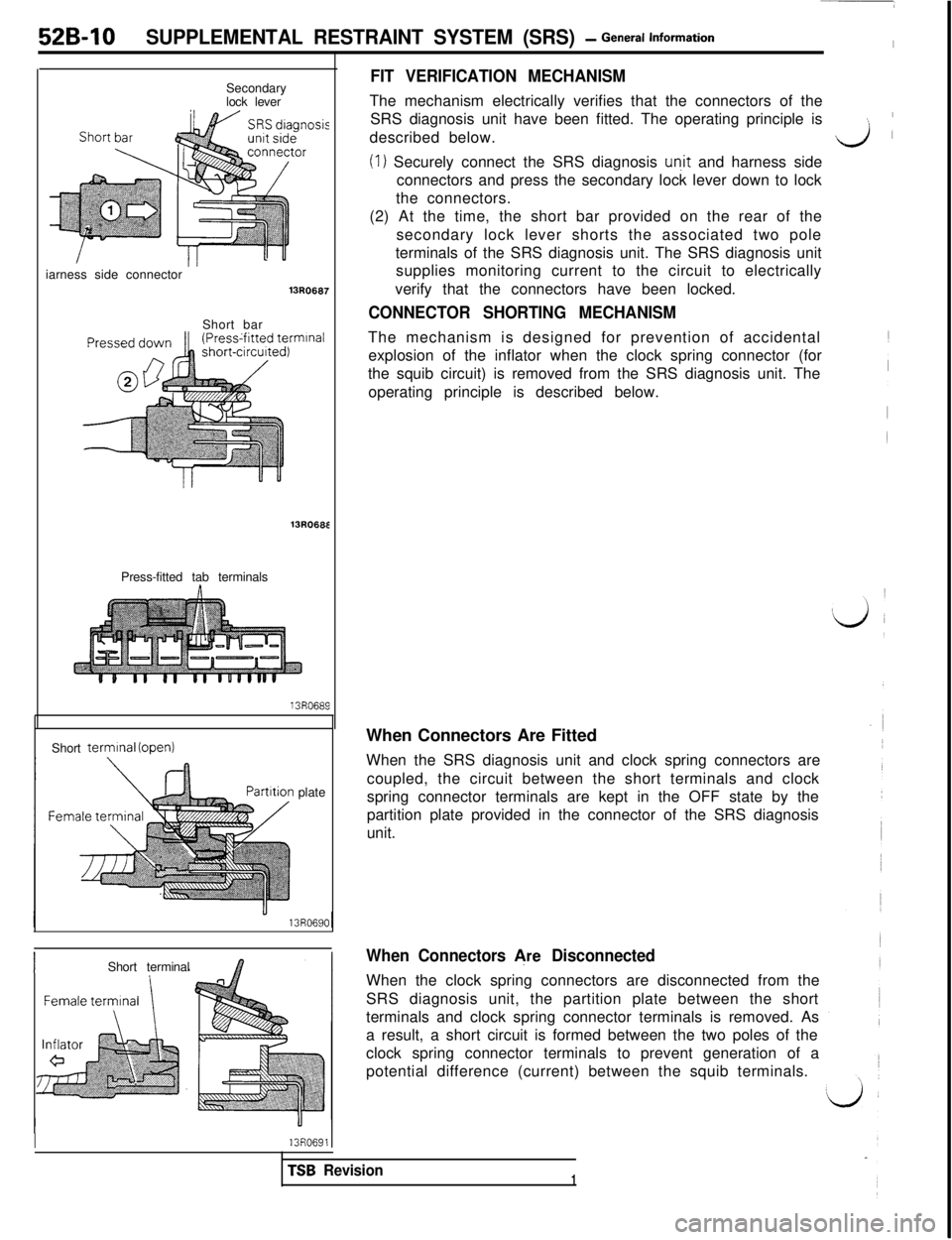
52B-10SUPPLEMENTAL RESTRAINT SYSTEM (SRS) - General InformationI
FIT VERIFICATION MECHANISMSecondary
lock leverThe mechanism electrically verifies that the connectors of the
SRS diagnosis unit have been fitted. The operating principle is
:described below.
d
(
(1) Securely connect the SRS diagnosis un.it and harness side
connectors and press the secondary lock lever down to lock
the connectors.
sisiarness side connector
13R0687Short bar
nlnal13R068E
Press-fitted tab terminals
13R0689Short
terminal (open)
plate
IShort terminal
I13R06911(2) At the time, the short bar provided on the rear of the
secondary lock lever shorts the associated two pole
terminals of the SRS diagnosis unit. The SRS diagnosis unit
supplies monitoring current to the circuit to electrically
verify that the connectors have been locked.
CONNECTOR SHORTING MECHANISMThe mechanism is designed for prevention of accidental
explosion of the inflator when the clock spring connector (for
the squib circuit) is removed from the SRS diagnosis unit. The
operating principle is described below.
When Connectors Are Fitted
When the SRS diagnosis unit and clock spring connectors are
coupled, the circuit between the short terminals and clock
spring connector terminals are kept in the OFF state by the
partition plate provided in the connector of the SRS diagnosis
unit.
When Connectors &e DisconnectedWhen the clock spring connectors are disconnected from the
SRS diagnosis unit, the partition plate between the short
terminals and clock spring connector terminals is removed. As
a result, a short circuit is formed between the two poles of the
clock spring connector terminals to prevent generation of a
potential difference (current) between the squib terminals.
TSB Revision1